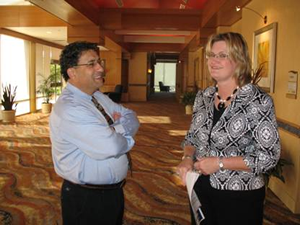 |
Approximately 50 people from North America, the United Kingdom, Austria, Spain and Norway, attended Applied Market Information’s (AMI) "Plastics in Underground Pipe 2009" conference in Orlando, Florida on 6 and 7 May. Pipe conferences are invariably good events to learn about the performance characteristics of high-density polyethylene (HDPE) for extension to geomembranes and other geosynthetics. This conference was no exception.
Prof. Alexander Chudnovsky (University of Illinois at Chicago) raised the comment that while we may do all kinds of calculations on data generated from accelerated laboratory tests to generate pipe and geomembrane lifetimes, very few of these extrapolations take into account the actual aging of the material that occurs in the field—the synergism of UV exposure, thermal cycling, residual stress, stress cycling, chemical environment, etc.
When Rick Thomas (TRI) mentioned that Stepped Isothermal Method (SIM) testing was used to extrapolate 24 hr temperature/strain data to 10,000 hr creep data, and that it followed conventional 10,000 polyester (PET) fiber creep, Prof. Chudnovsky commented, "Well, that just shows how bad conventional creep testing is!"
It makes one think, though.
How often do we do accelerated laboratory tests that by default assume the sample will be in the same condition in 10,000 hours, 100 years, or 1000 years? Material will oxidize as it creeps, stress will cause additives to migrate, thermal cycling will cause stresses to cycle, welding and associated notches will cause additional oxidation and stress concentrations, etc. He has a point, one with which both Rick and I agreed.
 |
Another point of discussion between Rick, me, and Alex was whether or not HDPE’s surface stabilizers are replaced by diffusion of deeper stabilizers as they are consumed while providing protection against oxidation. Or do the surface stabilizers get consumed faster than they can be replaced such that surface oxidation occurs (surface layer OIT goes to zero) and stress cracks initiate while there is still a high OIT in the center of the geomembrane/pipe wall. Vociferous and positive though Rick was during the question period after Alex’s presentation, the general consensus is that oxidation of the surface occurs first, as proposed by Alex and me.
It was great to renew acquaintances with old geomembrane contacts such as Adel Haddad (Dow), now with LyondellBasell, and Steve Sandstrum (Solvay), who is now with ISCO.
It was interesting to hear Gene Palermo talking about rapid crack propagation (RCP) in modern HDPE pipes typically brought about by impact stresses on the surface. I mentioned that the RCP we saw in HDPE geomembranes in the 1980s appeared to be initiated by slow crack growth (SCG) stress cracks that reached a critical size while growing at a critical speed. In pipe SCG cracks have certainly been seen at the start of RCP cracks, but there has always been an associated impact event. Therefore, if we can continue to avoid SCG cracks in HDPE geomembranes, we should also be able to continue to avoid exposed liner RCP shattering failures.
During the conference I suggested to AMI that they consider organizing a conference on maximum allowable leak flow rates through geomembrane liners and methods of locating leaks in liners. Let’s see what happens.
Ian D. Peggs is the president of I-CORP INTERNATIONAL in Ocean Ridge, Florida. He can be reached at icorp@geosynthetic.com.











